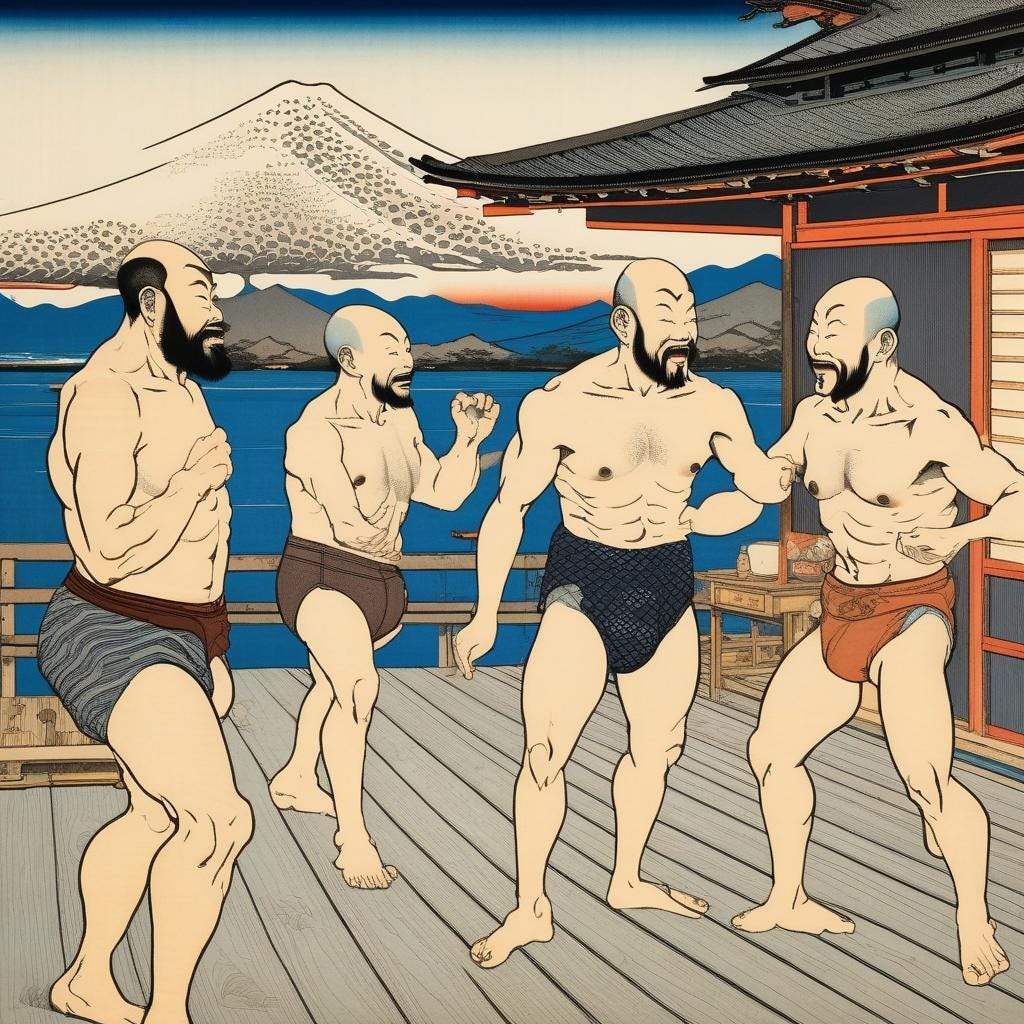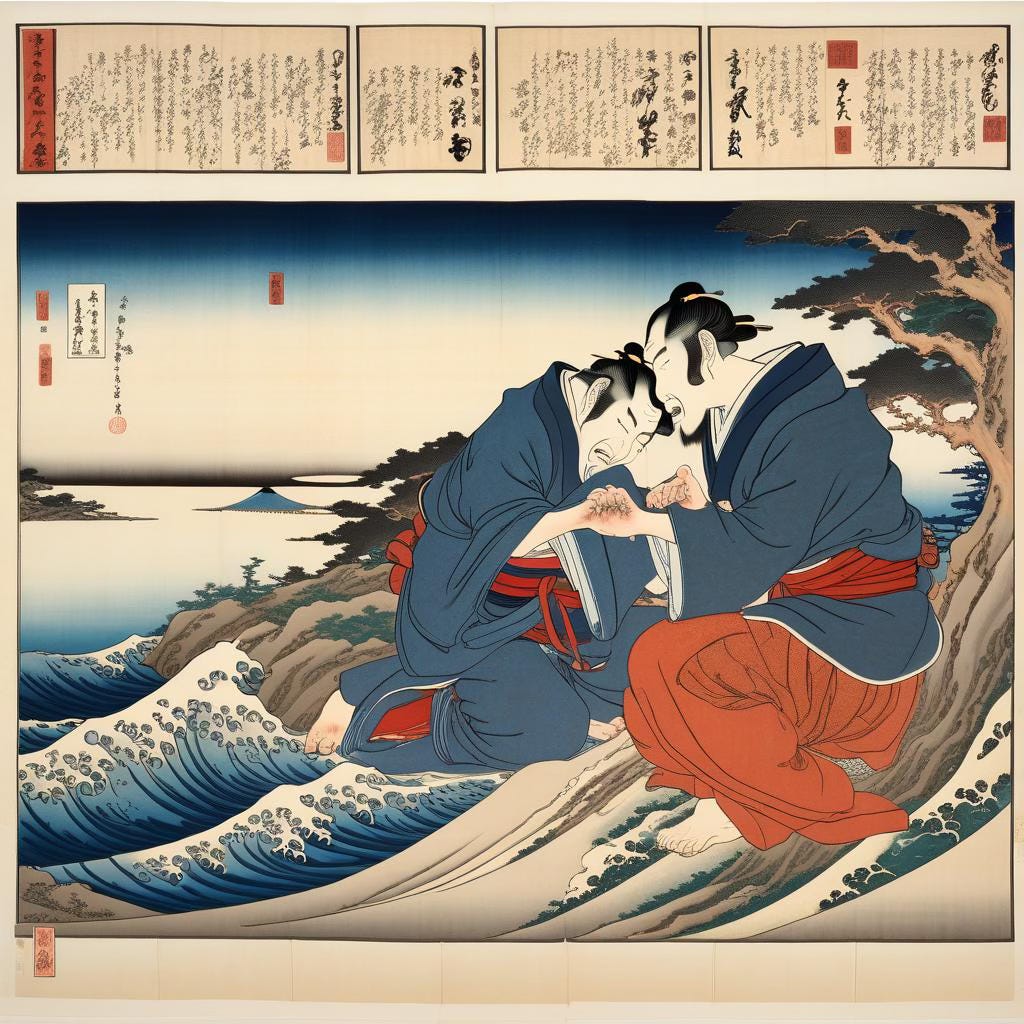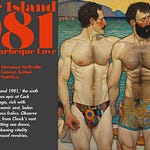Japanese have a flair for penises, it’s hard not to admit. Between the annual Kanamara Matsuri (かなまら祭り) or Fesival of the Steel Penis (warning: if you click you will see young girls with amusing lollipops), and Shunga artwork with titanic penises, usually 1/3 to 1/2 the length of the owner… it’s hard to put your finger on what’s exactly what’s so amusing about it all. Unfortunately for this 7th volume of the AI generated summer Fire Island books series, I could not coax a staggering phallus out of them, because of their ever-present guard rails. Instead, I used the edo-period artist Hokusai, for the image target, and the language target of Argentine writer Jorge Luis Borges, of labyrinthine fame. This synoptic video is a summary of what went on in 1982 with our crew, when gay life took a decidedly gay turn with the full-blown advent of information about HIV/AIDS, and the devastation it started on the gay community.
I think Borges would have appreciated AI generation of books and ‘texts’ - in the 80’s it was all about the ‘text’ in literary circles, and (as always) I was late to the game reading "Ficciones” by then (Grove Press had an English translation out two decades earlier, along with his other works.) His work had a strange timelessness, like Calvino and Kafka, as well as Poe, Murukami and Nabokov, an effect I find ever-present in AI generated texts, and hard to overcome. The annoying word for it ‘discursive’, the easy word is fragmented or rambling. Often it’s hard to control large text AI generation when the AI turns on itself, and begins commenting on the chapter structure, the writer, and the text - we used to call that ‘going meta’. Nabokov “Pale Fire” loves that, as I spoke of the last volume of images having image-in-image-in-image, AI also produces text-in-text-in-text. I have an Erotic (naturally) Tarot system I developed with a photographer friend, the same voice you have with this video, and structured so you can verbally interact with it in stories - with a beautiful background piano soundtrack of chord progressions locked to the reading. Occasionally, the reading commences with the card being itself about a Tarot reader selecting an alternate card than the draw, and providing a complete interior nested reading to the layers of discussion. Discursive.
Image Bias: The images by Hokusai reflect the different generative image problems mentioned in prior chapters, the first being feature bias. In this case, absolutely no European features would ever emerge spontaneously from any generated image whatsoever. i tried manually to intercede in the AI-generated prompts (Remember from prior volumes, it’s all AI: the network of AI’s, a chapter, section, summary generation set, which create prompts for the visual set. The guidance of body hair enforcement generally worked, which of course is odd. Most Asian men are fairly smooth, in Japan these would be equivalent to perhaps the Ainu of northern Japan. I left the rule in. However neglecting European feature bias, some African features cropped up without difficulty.
Male Kissing: impossible apparently. I was fairly sure at the onset if there wasn’t Shungu in the formula somehow, there would be no erotic interplay among the characters, and that wa that. There were some close-face moments, but nothing I could possibly interpret from my American sensibility as affection.
Double-Eyebrow: there’s something also in the generative training that spontaneously creates double-eyebrows on some characters. I know that Hikimayu (引眉) or the practice of shaving eyebrows and re-drawing them as a smudge was prevalent prior to the Edo period, but only with women. I was of two minds to delete double-eyebrow images, along with double-Mt. Fuji images, but I left them to be more example than final illustration, the chapter illustrations in the typeset book only have a single image for each chapter.
Words: I speak and read many language, but not Japanese. I suspect the calligraphy is meaningless, sadly, on the images; if they weren’t I’d be shocked.
As always, enjoy.

















Share this post